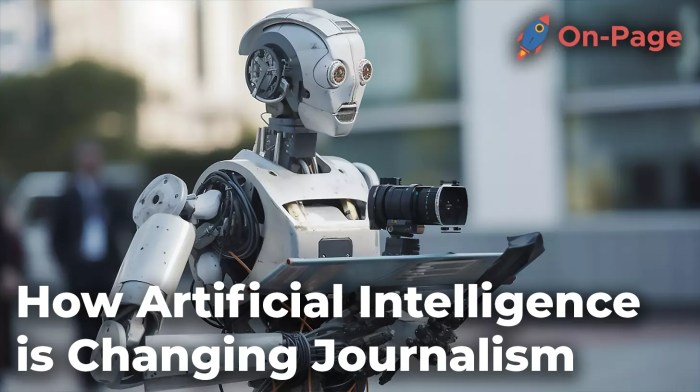How will artificial intelligence impact the news industry? It’s a question that’s got everyone buzzing, from the seasoned journalists to the casual news consumer. Will robots be writing our headlines? Will algorithms be deciding what we read? The answer, my friends, is a resounding “maybe,” and it’s a lot more interesting than you might think.
AI is already making its mark on the news landscape, with tools that can generate articles, analyze data, and even personalize news feeds. But is this the dawn of a new era of journalism, or a threat to the very fabric of truth and trust?
We’re about to dive into the exciting, and sometimes unsettling, world of AI in the news, exploring the potential benefits and risks, and trying to figure out what it all means for the future of how we get our news.
Automation of Content Creation
Imagine a world where news articles write themselves. This isn’t science fiction; it’s the reality of artificial intelligence (AI) entering the newsroom. AI can now generate news articles, summaries, and even social media posts, transforming the way we consume and produce news.
AI-Generated Content: Benefits and Drawbacks
AI’s potential to automate content creation is undeniably enticing. It promises to streamline the news production process, offering numerous benefits, but also presents some significant drawbacks.
- Accuracy: AI algorithms can analyze vast amounts of data, potentially leading to more accurate reporting. They can identify patterns and trends that might escape human observation, resulting in deeper insights and more comprehensive coverage. However, AI algorithms are only as good as the data they are trained on.
Biased or incomplete data can lead to inaccurate or misleading reports.
- Speed: AI can generate content much faster than humans. This allows news organizations to break stories quicker, publish updates more frequently, and cater to the ever-increasing demand for instant information. However, speed can come at the cost of accuracy and quality.
- Creativity: While AI can produce factual and informative content, it struggles to match human creativity and originality. AI-generated content often lacks the nuanced storytelling, emotional impact, and unique perspectives that make human-written news engaging.
Examples of AI Tools in Newsrooms
Several AI tools are already being used in newsrooms to automate content creation:
- Automated News Writing: Companies like Automated Insightsand Wordsmithhave developed AI-powered platforms that can generate basic news articles, summaries, and financial reports based on data feeds.
- Social Media Management: AI tools like BuzzSumoand Hootsuitecan analyze social media trends, identify popular topics, and schedule social media posts.
- Content Translation: AI-powered translation tools like Google Translatecan quickly translate news articles into multiple languages, expanding the reach of news organizations.
Personalized News Experiences
Imagine a news feed that only shows you stories you actually care about, tailored to your unique interests and preferences. This is the promise of AI-powered personalized news experiences. AI algorithms can analyze your reading habits, social media interactions, and even your location to curate a news feed that’s relevant and engaging.
Impact on Media Consumption Habits
Personalized news feeds can significantly impact how people consume media. By filtering out irrelevant information, AI can make news more accessible and engaging, potentially increasing news consumption and civic engagement. However, there are also concerns about the potential for echo chambers and filter bubbles, where users are only exposed to information that confirms their existing biases.
This can lead to a lack of exposure to diverse perspectives and hinder critical thinking.
Learn about more about the process of How to balance work and personal life for well-being in the field.
Data Analysis and Reporting: How Will Artificial Intelligence Impact The News Industry
Imagine a newsroom where mountains of data are not daunting obstacles but rich opportunities for uncovering hidden truths and crafting compelling stories. This is the promise of artificial intelligence (AI) in news reporting, empowering journalists to analyze vast datasets and unearth insights that would otherwise remain buried.
AI-Powered Data Analysis: Unveiling Patterns and Trends, How will artificial intelligence impact the news industry
AI can be used to analyze vast datasets of news articles, social media posts, and other data sources, identifying patterns and trends that might escape human notice. Natural language processing (NLP) algorithms can analyze text data to extract key themes, sentiment, and relationships between entities.
Machine learning models can identify anomalies and outliers, uncovering potential stories that might otherwise be missed. For example, AI can analyze social media data to identify emerging trends, track the spread of misinformation, or even predict the outcome of elections.
Investigative Journalism and Fact-Checking: AI’s Role
AI-powered data analysis is a powerful tool for investigative journalism and fact-checking. By analyzing large datasets, journalists can uncover hidden connections, identify inconsistencies in narratives, and verify the authenticity of information. AI can help journalists to:
- Identify potential sources of misinformation:By analyzing social media data, AI can identify accounts that are spreading false information or engaging in coordinated campaigns.
- Uncover hidden connections:AI can analyze databases of financial transactions, corporate records, and other data to uncover hidden connections between individuals, organizations, and events.
- Verify the authenticity of images and videos:AI can analyze images and videos to detect manipulations, forgeries, and other forms of digital manipulation.
News Organizations Embracing AI
Several news organizations are already using AI for data analysis and reporting. The Associated Press (AP) uses AI to automate the generation of basic news reports, such as earnings reports and sports scores. The Washington Post uses AI to analyze data and create interactive visualizations.
The BBC uses AI to identify potential fake news stories and to personalize news recommendations for users.
“AI is not going to replace journalists, but journalists who use AI will replace those who don’t.”
Jeff Jarvis, media commentator
AI-Powered Journalism Tools
Imagine a world where journalists can translate interviews in real-time, transcribe audio recordings with incredible accuracy, and analyze images to uncover hidden details – all thanks to the power of artificial intelligence. This future is already unfolding, and AI-powered journalism tools are rapidly changing the landscape of newsgathering and reporting.
Impact of AI-powered Tools on Journalism
AI-powered tools are revolutionizing the way journalists work, offering numerous benefits and presenting new challenges. They are transforming journalism by automating tedious tasks, enhancing efficiency, and enabling deeper analysis and insights. These tools are helping journalists to:
- Save time and resources: By automating tasks like transcription, translation, and image analysis, AI tools free up journalists to focus on more creative and strategic aspects of their work.
- Improve accuracy and efficiency: AI-powered tools can help journalists to produce more accurate and reliable content by automating tasks that are prone to human error.
- Uncover new insights: AI can analyze large datasets and identify trends that might be missed by human analysts, leading to more insightful and nuanced reporting.
- Reach a wider audience: AI-powered translation tools can help journalists to reach a global audience by making their content accessible in multiple languages.
However, the rise of AI in journalism also raises concerns about:
- Job displacement: Some argue that AI tools could eventually replace human journalists, particularly for tasks that are easily automated.
- Bias and accuracy: AI algorithms are only as good as the data they are trained on, and they can perpetuate biases that are present in the data.
- Transparency and accountability: It is important to ensure that AI-powered tools are used transparently and that journalists are accountable for the content they produce.
AI-Powered Journalism Tools: A Comparison
The following table provides a comparative overview of some popular AI-powered journalism tools:
| Tool | Features | Capabilities |
|---|---|---|
| Google Translate | Supports over 100 languages, translates text, documents, and websites, offers pronunciation guides. | Facilitates cross-language communication, enables journalists to access and report on global events. |
| Otter.ai | Transcribes audio and video recordings with high accuracy, generates summaries and timestamps, supports multiple languages. | Streamlines transcription, saves time for journalists, allows for quick analysis of interviews and speeches. |
| Clarifai | Identifies objects, faces, and scenes in images, provides detailed descriptions and tags, analyzes image sentiment. | Enhances image analysis, helps journalists to verify images and uncover hidden details, adds context to visual storytelling. |
| Reporters Without Borders’ “AI for Journalists” | Offers a curated list of AI tools for journalists, provides training resources and guides, promotes ethical use of AI in journalism. | Connects journalists with relevant AI tools, supports ethical and responsible use of AI in the newsroom. |
The rise of AI in journalism is undeniable. While it presents both opportunities and challenges, AI-powered tools have the potential to revolutionize the way news is gathered, analyzed, and shared. By embracing these tools while addressing ethical concerns, journalists can leverage AI to enhance their work and deliver more informed and engaging content to their audiences.
Ethical Considerations
The rise of AI in the news industry brings with it a host of ethical considerations. As algorithms become increasingly involved in news gathering, content creation, and dissemination, it’s crucial to ensure that their use is responsible, transparent, and unbiased.
This involves addressing potential biases in AI systems, promoting transparency in AI-driven journalism, and establishing clear accountability mechanisms.
Bias in AI Systems
AI systems are trained on vast datasets, and these datasets can reflect existing biases present in society. This can lead to AI-generated content that perpetuates or even amplifies existing biases, potentially resulting in discriminatory or unfair representations. For instance, an AI-powered news aggregator trained on a dataset skewed towards a particular political ideology might prioritize news sources that align with that ideology, potentially excluding diverse perspectives.
Transparency in AI-Driven Journalism
Transparency is paramount in the news industry, and it becomes even more crucial when AI is involved. It’s essential to clearly disclose when AI is used in news production, explaining the role of AI in the process and the limitations of the technology.
This helps readers understand the context of the information they’re consuming and allows them to evaluate the reliability of the content. For example, a news article generated with the help of AI should clearly state that AI was used, outlining the specific tasks the AI performed and the human editors involved in the process.
Accountability for AI-Generated Content
Establishing clear accountability mechanisms is essential for ensuring ethical and responsible use of AI in journalism. It’s important to determine who is responsible for the content generated by AI systems, especially when it comes to factual accuracy and potential biases.
This might involve a combination of human editors, AI developers, and the news organization itself, with clear roles and responsibilities defined for each party.
Ethical Challenges Related to AI-Generated Content and AI-Powered Journalism Tools
- Algorithmic Bias:AI systems can perpetuate existing societal biases, leading to discriminatory or unfair representations in news content. For example, an AI-powered news aggregator trained on a dataset skewed towards a particular gender or race might prioritize news sources that reflect those biases, potentially excluding diverse perspectives.
- Lack of Transparency:The use of AI in news production should be transparent, with clear disclosure of the role of AI in the process and the limitations of the technology. This helps readers understand the context of the information they’re consuming and allows them to evaluate the reliability of the content.
- Misinformation and Fake News:AI can be used to generate realistic-looking fake news articles, making it harder for readers to discern truth from falsehood. This can erode public trust in the news and have a negative impact on public discourse.
- Job Displacement:The automation of tasks previously performed by human journalists could lead to job displacement in the news industry. This raises concerns about the future of journalism and the potential for AI to exacerbate existing inequalities in the field.
- Privacy Concerns:AI-powered tools can collect and analyze vast amounts of data, raising concerns about user privacy. It’s important to ensure that data is collected and used ethically and responsibly, with appropriate safeguards in place to protect user privacy.
Future Trends
The future of AI in the news industry is brimming with possibilities, promising a landscape where news gathering, creation, and consumption are redefined. AI’s capabilities are rapidly advancing, leading to innovative applications that will reshape the role of journalists and the very nature of news itself.
Impact of AI Advancements
The evolution of AI will continue to impact the news industry in profound ways. Advancements in natural language processing (NLP), machine learning (ML), and computer vision will enable AI to perform tasks that were once considered exclusively human. For instance, AI-powered systems will be able to analyze vast amounts of data from various sources, including social media, government databases, and sensor networks, to identify emerging trends and potential news stories.
This capability will empower journalists to focus on in-depth reporting and analysis, while AI handles the time-consuming task of data collection and processing.
Closing Notes

So, will robots be writing our headlines? Maybe. Will algorithms be deciding what we read? Possibly. But one thing’s for sure: the future of news is going to be a fascinating blend of human ingenuity and artificial intelligence.
As we navigate this evolving landscape, it’s crucial to remember the importance of critical thinking, fact-checking, and ensuring that the news we consume is reliable and accurate. After all, a well-informed public is the cornerstone of a healthy democracy, whether the news is delivered by a human or a machine.
Popular Questions
Will AI replace journalists?
While AI can automate certain tasks, it’s unlikely to completely replace journalists. Human creativity, critical thinking, and ethical judgment are still essential for quality journalism.
What are some examples of AI-powered journalism tools?
There are many, including tools for language translation, transcription, image recognition, and even generating news summaries.
How can I be sure the news I read is accurate?
Be critical of sources, check for multiple perspectives, and look for reputable news organizations with a strong track record of accuracy.
 CentralPoint Latest News
CentralPoint Latest News




